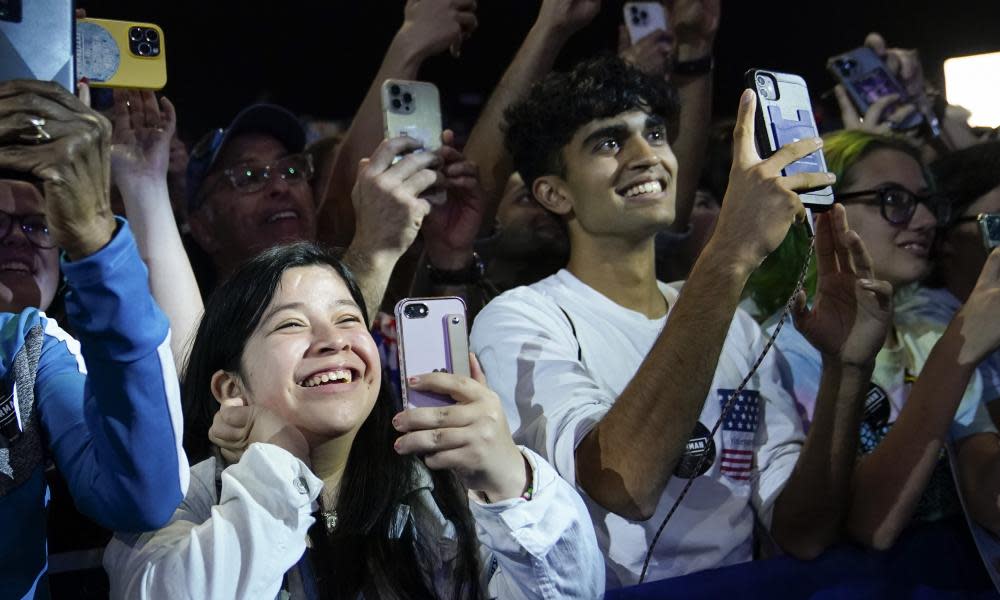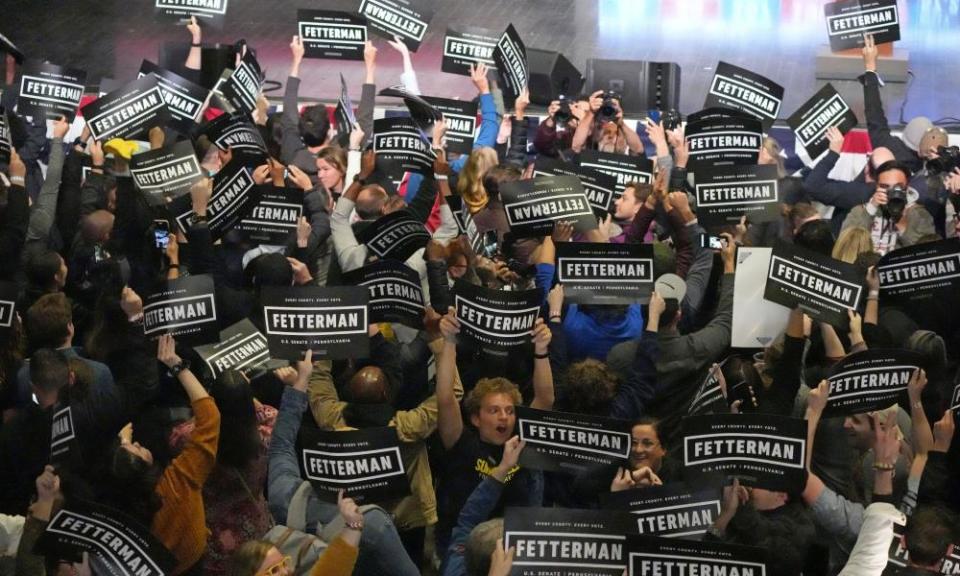How Gen Z agencies wooed Democratic voters: ‘Young people are nervous to trust politicians’

Democrats avoided a predicted “red wave”, and they have Gen Z to thank. Tuesday night’s big wins can largely be attributed to young voters, who showed up en masse and overwhelmingly voted blue.
Exit voting polls found that one in eight midterm voters were under 30, and 61% of those between the ages of 18 and 34 voted for Democrats. The results pushed the Fox News pundits Jesse Watters and Laura Ingram to suggest that the legal voting age should be increased to 21.
Partly responsible for high youth turnout was a new generation of political consultants who had been stumping behind the scenes for months, challenging the generalization that Gen Z is too lazy or disillusioned to bother casting ballots.
Related: First Gen Z member elected as midterms could usher in a more diverse Congress
Some of these strategists are essentially hipper and more digitally savvy startup versions of their more entrenched Beltway counterparts. Like traditional consultants, Gen Z research firms are hired by campaigns to target voters. But they are specifically tasked to reach young voters where they are. And, often, that’s TikTok.
“Gen Z is ageing into the electorate every single day. It can be a daunting new audience for traditional candidates to face and figure out,” said Ashley Aylward, who leads research at Hit Strategies, whose website boasts of “competency with communities of color, women, LGBTQ+, and younger audiences”.
The Democratic gubernatorial contenders Mandela Barnes and Chris Jones tapped Hit Strategies to work on their campaigns. The Washington-based group has also worked with movements such as Black Lives Matter and various ACLU chapters.
Aylward said Gen Z cared more about the issues than aligning themselves to a particular candidate. “Young people are a little nervous to trust politicians on delivering their promises,” she said. If you want to speak to jaded youth, Aylward recommends sticking to the script that details their unique challenges: school shootings, the climate crisis, debt, and the reversal of Roe v Wade. “One thing that really helped [Democratic candidates] was having abortion on the ballot, even if those measures were in other states,” she said. “We advised our clients to really make sure that they talked about it.”
But candidates also have to change the way they speak to young voters. One candidate who did this particularly well, according to Aylward, was John Fetterman, Pennsylvania’s next senator.
Fetterman, who spent spent $12m on communications consultants, posted lighthearted content online throughout his campaign. He jumped on TikTok’s Teenage Dirtbag trends and invited Jersey Shore’s Snooki (aka Nicole Polizzi) to make fun of his opponent Mehmet Oz’s Garden state roots. “There were memes and humor, and that really penetrated the social media market for young people who feel overwhelmed about the amount of political problems they’re facing,” Aylward said. “He was able to use the language of young voters while still having a plan and being serious.”
Related: Young voters hailed as key to Democratic successes in midterms
Gen Z strategists aren’t just working directly with candidates but also alongside political action groups and non-profits. Antonio Arellano is the vice-president of communications for Next Gen America, an advocacy group founded in 2013. Before the midterms, the 32-year-old Texan recruited 164 influencers to talk to their followers about issues that would bring them to the polls: climate, gun control, reproductive rights. The effort reached an audience of 65 million. The influencers were paid and had to declare so, but, crucially, Arellano still gave them a lot of latitude on what they said.
“We gave the influencers high-level talking points about issues and why they’re important, and then said, ‘Incorporate this into your content in whatever way you want,’” said Arellano. “If you’re a comedian, make a joke about it. If you’re an actor, do a skit. We didn’t tell them what to say. We really leaned into their voice and genuine lived experience to drive the message home.“If an influencer is angry, frustrated, upset, we want them to use their voice and express it that way.”

Rage works, but going forward Arellano suggests reminding Gen Z at every opportunity just how much their actions can shape elections. “What we saw overwhelmingly when we were out on the campaign is that young people weren’t aware of how much their contributions to 2020 delivered substantial wins,” he said. “We have the Inflation Reduction Act, investment in climate change, student debt relief, and conversations about marijuana reform. Let’s own and claim these victories for Gen Z. It’s about bragging better about our accomplishments, not just after the midterms but in the lead-up to elections, too.”
Aylward conducts focus groups and surveys where she’s found that reminding young people of times their bloc helped sway the results of an election “helps remind them as an individual that they’re part of a larger group that can make change”.
“It helps get through the high level of anxiety young people feel, because they’re so overwhelmed at the high amount of issues they have to tackle,” she said.
Not everyone in the field is certain these strategies are effective. Ziad Ahmed, CEO of the Gen Z-staffed firm JUV Consulting, still believes Gen Z needs to focus on more traditional get out the vote tactics on the ground.
He says Beto O’Rourke and Val Demings were the two candidates who showed up most in his TikTok #ForYouPage. But both lost their races. “I’m not necessarily convinced that content always translates into results. A lot of content on TikTok from people is from people who are not in the states where I lived. I loved those candidates, but they were thousands of miles away. Social media is not often localized enough to impact voters.”
The States of Change project predicts that Gen Z and millennials will be the largest voting bloc by age in 2024, responsible for 45% of all ballots cast. Baby Boomers will account for 25%. Aylward expects to consult with more candidates on how to target the youth. She admits that some of her advice, like getting on TikTok, seems a little bit “obvious”.
“The reason why is because we don’t have people who are interested in reaching out to young voters,” she said. “Sometimes the obvious answers are the right answers; people just aren’t using them. I hope people will try to engage more in the future.”

 Yahoo News
Yahoo News 
